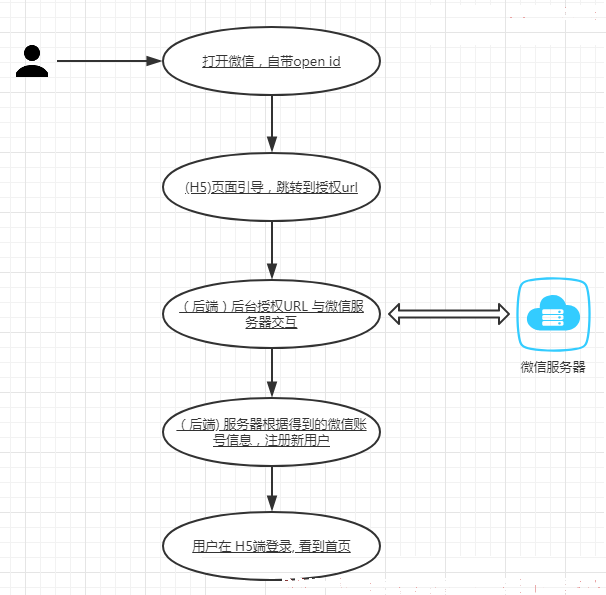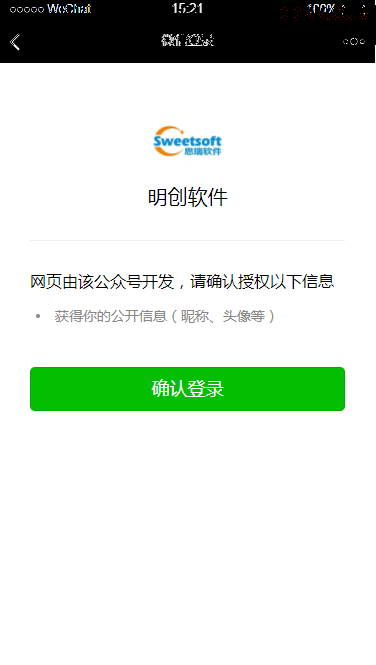56、用户的注册和微信授权
为了追求快速上线,项目组决定,去掉传统项目中的“用户注册”, “用户登录”, 直接使用微信的账户来核对。
1、 用户的微信浏览器带着当前微信用户的open_id,跳转到“后台服务器”;
2、 “后台服务器”给“微信服务器”发送请求获得当前微信用户的信息;
3、 “后台服务器”为该用户生成一个用户文件;
4、 “后台服务器”告知“H5端”已经成功注册该用户;
5、 “H5端”为该用户展示对应的页面;
如下图所示:

可以看出, 主要代码都是在 服务器端。
1. 让微信用户打开首页后,直接跳转到后台服务器
1、 1修改对应的路由文件(src/router/index.js):;
Vue.use(Router)
export default new Router({
routes: [
{
path: '/wait_to_shouquan',
name: 'wait_to_shouquan',
component: require('../views/wait_to_shouquan.vue')
},
]
})
1、 2增加对应的vue(src/views/wait_to_shouquan.vue):;
<template>
<div style="padding: 50px;">
<h3>正在跳转到授权界面...</h3>
</div>
</template>
<script>
export default {
created () {
window.location.href = this.$store.state.web_share + "/auth/wechat"
},
components: {
}
}
</script>
可以看到, 上面的代码中, 使用到了 Vuex 来保存系统变量(后台服务器的地址) .
1、 3增加核心模板文件(src/main.vue):
<template>
<div id="app">
<router-view></router-view>
</div>
</template>
<script>
import store from './vuex/store'
import { SET_BASEINFO, GET_BASEINFO } from './vuex/mutation_types'
export default {
store,
name: 'app',
data () {
return {
user_info: {
open_id: this.$route.query.open_id
}
}
},
mounted () {
// TODO 开发环境下使用, 生产环境下注释掉
// store.dispatch(SET_BASEINFO, {open_id: 'opFELv6YkJkMaH-xFkokTWCs5AlQ'})
if (this.user_info.open_id) {
store.dispatch(SET_BASEINFO, this.user_info)
} else {
store.dispatch(SET_BASEINFO)
if (store.state.userInfo.open_id === undefined) {
console.info('用户id和open_id不存在, 跳转到授权等待页面')
this.$router.push({name: 'wait_to_shouquan'})
} else {
console.info('已经有了BASEINFO')
}
}
},
watch: {
'$route' (val) {
}
},
methods: {
},
components:{
}
}
</script>
<!-- 下方的 CSS 略过 -->
可以看到, 上面代码的 mounted() 方法中, 会对 当前用户的open_id 进行判断. 如果存在,调到首页。 如果不存在,表示该用户是新用户。 需要跳转到授权等待页面。对应的代码如下所示:
if (this.user_info.open_id) {
store.dispatch(SET_BASEINFO, this.user_info)
} else {
store.dispatch(SET_BASEINFO)
if (store.state.userInfo.open_id === undefined) {
console.info('用户id和open_id不存在, 跳转到授权等待页面')
this.$router.push({name: 'wait_to_shouquan'})
} else {
console.info('已经有了BASEINFO')
}
}
1、 4增加对应的Vuex代码;
目前来看, Vuex需要保存2个信息:
- 用户的open id
- 远程服务器的地址,端口等常量.
1、 4.1增加src/vuex/store.js.这个是最最核心的文件完整如下所示:
import Vue from 'vue'
import Vuex from 'vuex'
import userInfo from './modules/user_info'
import tabbar from './modules/tabbar'
import toast from './modules/toast'
import countdown from './modules/countdown'
import products from './modules/products'
import shopping_car from './modules/shopping_car'
import * as actions from './actions'
import * as getters from './getters'
Vue.use(Vuex)
Vue.config.debug = true
const debug = process.env.NODE_ENV !== 'production'
export default new Vuex.Store({
state: {
web_share: 'http://shopweb.siwei.me',
h5_share: 'http://shoph5.siwei.me/?#'
},
actions,
getters,
modules: {
products,
shopping_car,
userInfo,
tabbar,
toast,
countdown
},
strict: debug,
middlewares: debug ? [] : []
})
上面的代码中, 部分代码是在后面会陆续用到的。 我们不用过多考虑。 只需要关注下面几行:
export default new Vuex.Store({
// 这里定义了若干系统常量
state: {
web_share: 'http://shopweb.siwei.me',
h5_share: 'http://shoph5.siwei.me/?#'
},
modules: {
// 这里定义了 当前用户的各种信息, 我们把它封装成为一个js对象
userInfo,
},
})
1、 4.2增加vuex/modules/user_info.js这个文件:
import {
SET_BASEINFO,
CLEAR_BASEINFO,
GET_BASEINFO,
COMMEN_ROLE,
GET_BGCOLOR,
GET_FONTCOLOR,
GET_BORDERCOLOR,
GET_ACTIVECOLOR,
EXCHANGE_ROLE
} from '../mutation_types'
const state = {
id: undefined, //用户id
open_id: undefined, // 用户open_id
role: undefined
}
const mutations = {
//设置用户个人信息
[SET_BASEINFO] (state, data) {
try {
state.id = data.id
state.open_id = data.open_id
state.role = data.role
} catch (err) {
console.log(err)
}
},
//注销用户操作
[CLEAR_BASEINFO] (state) {
console.info('清理缓存')
window.localStorage.clear()
},
}
const getters = {
[GET_BASEINFO]: state => {
console.info('进入到了getter中了')
let localStorage = window.localStorage
let user_info
if (localStorage.getItem('SLLG_BASEINFO')) {
console.info('有数据')
user_info = JSON.parse(localStorage.getItem('SLLG_BASEINFO'))
} else {
console.info('没有数据')
}
return user_info
},
[COMMEN_ROLE]: state => {
if (state.role === 'yonghu') {
return true
} else {
return false
}
},
}
const actions = {
[SET_BASEINFO] ({ commit, state }, data) {
//保存信息
if (data !== undefined) {
let localStorage = window.localStorage
localStorage.setItem('BASEINFO', JSON.stringify(data))
commit(SET_BASEINFO, data)
} else {
if (localStorage.getItem('BASEINFO')) {
data = JSON.parse(localStorage.getItem('BASEINFO'))
commit(SET_BASEINFO, data)
} else {
}
}
}
}
export default {
state,
mutations,
actions,
getters
}
该文件定义了用户的信息的各种属性。
1、 4.3增加src/vuex/mutation_types.js;
export const SET_BASEINFO = 'SET_BASEINFO'
export const GET_BASEINFO = 'GET_BASEINFO'
上面内容定义了该对象的两个操作。
1、 4.4增加src/vuex/modules/actions.js;
import * as types from './mutation_types'
可以看到上面的内容对于 mutation_types 进行了引用。
1、 4.5增加src/vuex/modules/getters.js;
// 先放成空内容好了
这个文件先这样存在,目前阶段不需要有任何内容。
1.5 与后台的对接
后台的同学, 为我们提供了一个链接入口:
http://shopweb.siwei.me/auth/wechat
我们让H5页面直接跳转过去就可以。 这里不需要加任何参数, 直接由后端的同学搞定接下来的事情。
查看效果
在微信开发者工具中,打开我们的H5 页面, 就会看到页面会自动跳转.
观察仔细的同学可以看到有两次跳转:
第一次跳转到
http://shopweb.siwei.me/auth/wechat
第二次跳转到
https://open.weixin.qq.com/connect/oauth2/authorize…
如下图所示:

点击“确认登录”按钮,进行授权后,就会进入到H5的首页
总结
本节中,为了做一件事: 让用户跳转到微信授权,并注册, 我们做了如下的程序层面的内容:
- 使用Vuex 记录系统常量(远程服务器的地址)
- 使用Vuex 记录用户的信息(新增了一个对象:user_info)
- 使用了一个独立的页面(等待微信授权页面)
- 每次打开首页之前,都要判断该用户是否登录。
- (后台任务) 让该用户在微信端授权, 并且在本地生成一个新的用户, 然后把相关数据返回给前端
Vuex 是Vuejs 最复杂最不好理解的地方。 同学们不要怕。 之所以这么麻烦, 可以认为是javascript的语言特性决定的。 就好像java, C语言中大量用到的设计模式, 在现代编程语言(Ruby , Python, Perl)中就用不到, 可以有更加简单的办法, 例如Mixin)
另外,本节对于后端的同学是个挑战, 不但要在微信端做修改,还需要对微信返回的数据结构很熟悉。 由于本书内容所限,不再赘述。
版权声明:「DDKK.COM 弟弟快看,程序员编程资料站」本站文章,版权归原作者所有